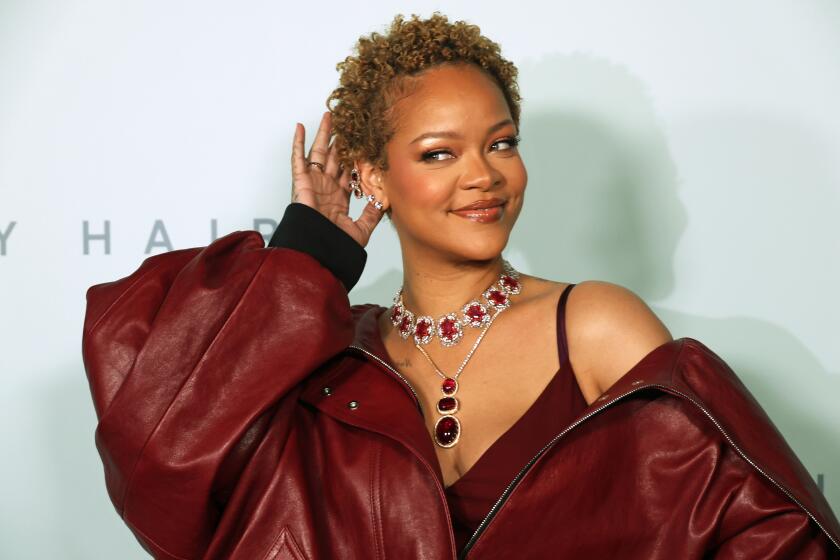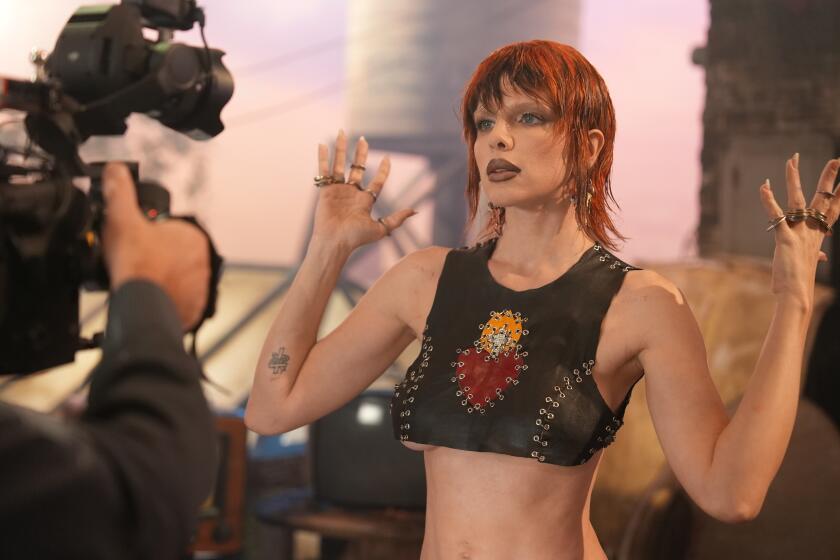For the New Air Jordans, Success Is a Shoo-In
It is a cultural ritual, like the unveiling of a new classic car model. Each fall for more than a decade now, basketball players, collectors and Michael Jordan fans have counted the days until the unveiling of the latest Air Jordan model.
“If I get some extra money,” says recreational ballplayer Taka Okubo, 25, “I would rather buy two pairs this year. One for playing, one for fashion.”
Indeed, although Nike has been particularly quiet this year about “Air Jordan XII”--due out Wednesday--demand seems as high as ever. The design--already circulated on the Internet and now seen in a low-key Nike commercial--is a futuristic departure from the generic-looking Jordans of recent years. This year’s stitched-and-padded shoe looks like a proper moonwalker and will probably come in white and black with combinations of black and red trim, the traditional Air Jordan color scheme.
And, of course, Jordan is back in the media spotlight with his short-lived retirement forgotten, a championship ring from last year’s NBA finals and a movie, “Space Jam,” in theaters now.
“People are calling the stores to ask when they are coming out,” says John Horan, publisher of the Sporting Goods Intelligence newsletter in Philadelphia. “Nike doesn’t have to go out and do a major television campaign when they can sell out of Air Jordans in a week.”
Even the popularity of boutique sneakers and skateboard shoes, bad press about deplorable labor conditions at Nike-approved factories in Indonesia, and the bloody “sneaker killings” of the late ‘80s haven’t tarnished the shoe’s success.
Jordans have in fact changed the athletic-shoe landscape, reintroducing nonwhite sneakers to the fray with red and black uppers, de-emphasizing the name-brand logo (Jordans were among the first Nikes to lose the traditional “swoosh” insignia on the side) and introducing a tugboat look that has swept the market.
And although even the best basketball shoes were once seen as disposable, the spaced-out Air Jordans have become the anchor for a new wave of high-end athletic shoes that some would rather store away than wear on a blacktop court. Collectors are fetching several hundred dollars for vintage Air Jordans at flea markets, and now some Nike models, including last year’s Air Jordans and Air Max, are becoming collectibles almost as soon as they’re out.
This is perhaps the first year, in fact, that the Air Jordan or any other athletic footwear will be considered collectible the instant it hits store shelves. Some stores are taking deposits on the $140 model and are already sold out. Others--such as Niketown in Beverly Hills--anticipate lines and even a one-day sellout. “Better come early and bring your sleeping bag,” warns one salesman.
Fans buy them for different reasons. Many want a piece of the Jordan mystique. Some just want a collectible shoe that will appreciate in value; others think their Jordan-assisted engineering is unbeatable on the court.
“I think Air Jordans are revolutionary basketball shoes,” says Okubo, who plays basketball at Venice Beach in every pair of his half-dozen Air Jordans. “The design, the style, the color. . . .”
Although competitors have tried to topple the 12-year reign of the Air Jordan (Reebok with its Shaquille O’Neal model, Fila with its Grant Hill shoe), none has come close. Even in the early ‘90s when collectors complained that the shoe had a boring, generic design (“The fourth through the 10th models were not so popular because they looked really similar and people were tired of them,” says a collector), it remained the most prestigious shoe in the sports world.
*
Nike keeps a tight leash on the Air Jordan, keeping catalog pictures from retailers until the weeks before its release, limiting information (Nike representatives did not respond to interview requests for this story) and limiting supplies so that few stores expect to carry the shoes longer than a week.
“They almost create the anticipation and demand and then hold back the supply,” says Larry Weindruck, spokesman for the National Sporting Goods Assn. in suburban Chicago. “They’re pretty astute when it comes to knowing what needs to be produced.”
Even advertising for the Air Jordan has become decidedly soft-sell, with little in the way of print ads and only a silent commercial featuring Jordan and his “jump man” logo in a flash. In Japan, fashion magazines circulated early pictures of the model in the same way car enthusiast magazines display “spy” photos of, say, an upcoming Porsche.
It works, leaving fans even more giddy with expectation. On the Internet, unofficial Nike and Jordan Web sites circulate bootleg photos of the upcoming shoe (“The ’97 Jordans!” gushes one) while stores get flooded with phone calls about the shoe’s release date.
“We don’t even get a chance to put them on display,” says the manager of one Westside athletic shoe store. “People put down a deposit early and they’re out the door the day they come in.”
Retailers from Japan, who can fetch three times the American retail price, are big customers at L.A. Nike retailers. Because Nike limits the quantity of Air Jordans it sends to Japan, Japanese retailers fly to L.A. and hop from store to store to buy the quantity and sizes they need. (Some retailers comb American flea markets for vintage Nikes, which can fetch as much as $3,000 in Japan.) While some stores will not sell quantities to Japanese buyers for fear they will alienate their day-to-day customers, others welcome the business.
“As long as they pay full retail,” says one retailer, “I don’t have a problem.”
Others do have a problem with Nike, however, saying the company is undersupplying smaller stores in favor of mega-chains such as Footlocker and its own Niketown stores.
“Niketown is becoming the top Nike retailer in town,” says the manager of a smaller shoe store. “The effect is that business is down 5% to 20%.”
*
The Air Jordan was the brainchild of Jordan’s ever-resourceful agent, David Falk, and became Nike’s savior in 1985. Against NBA warnings that the shoes were not regulation color, Jordan wore a black pair in the fall of ’85. It started a battle between Nike and the NBA that got plenty of free press--and the Air Jordan was born.
That year the model brought in $100 million for Nike and brought the shoemaker back from near-defeat after Reebok rocked the market with innovative aerobics sneakers that featured soft garment leather, running shoe soles and fresh colors. The Jordan has since helped Nike’s “Air” line--featuring hundreds of models in nearly a dozen categories such as basketball and tennis--propel the company to No. 1 in the U.S., with more than one-third of the $11-billion athletic-footwear market.
“The thing about basketball shoes, unlike many other sports, is that they are shoes you can wear in the street,” says Laurie Becklund, who co-authored “Swoosh: The Unauthorized Story of Nike and the Men Who Played there,” (Harcourt Brace Jovanovich, 1992). “And in athletic fashion, trends come from the inner city and move out.”
Today the Air Jordan has become a top-of-the-line draw, almost like a couture item, that seems intended to boost the sales of Nike’s more-affordable shoes rather than be an everyday court shoe.
“The Air Jordan creates cache for the rest of the Nike line,” Horan says.
“The reason Air Jordans are so popular now,” offers Okubo, “is that people who don’t play basketball also buy them.”



